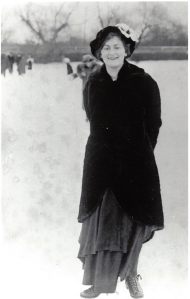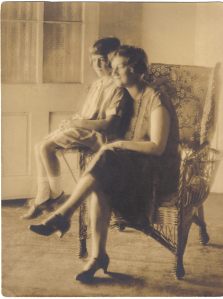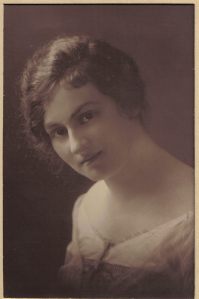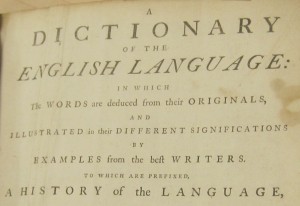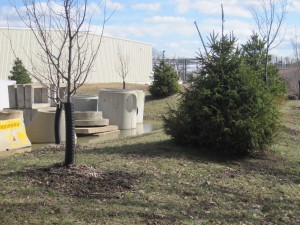“Grandma, tell me a story.” I was six years old. My mother’s mother, Eda Hoode Sadler, sat in her comfy chair, reading. She looked up, distracted for a moment and then smiled. She placed her book on the coffee table, took her glasses off and then gave the familiar pat on her lap. I climbed up and heard her groan as I settled in. How many times had I asked her for a story? How many times have I wished I could go back and hear her words that are lost forever? Within a year and a half, she was gone.

Eda Hoode Sadler with grandson, Fred Burwell. Note pad on grass and pencil in hand, ready for a writing session.
My grandmother’s life included more twists and turns than most plot-driven novels, but she didn’t talk about her eventful childhood. She told tales of magic and mystery. I remember an underwater world visited by two children – my age, of course – and populated by clever porpoises and other wild creatures. As much as I craved her stories, Grandma always made a deal. “I’ll tell you a story and then you tell me one,” she’d say. And so, from early on, I had the notion that you could pluck a story from the air.
At first glance, Grandma’s early life seems hidden behind an impenetrable bank of fog and yet there are tantalizing scraps, half-remembered stories from my mother, confusingly inconsistent “facts” from census records and naturalization documents, and autobiographical accounts in her unpublished novel, Jessica Brown, and in short stories. Ida Fingerhut was born in Poland in 1888 and traveled with her family to the United States just a few years later. Her father Abraham was a rabbinical student who contracted consumption while selling Christmas tree ornaments on the streets of New York and died soon after. In a letter to my mother, Grandma described him as “the quietest man imaginable,” and yet he, too, told stories. “My mother just absolutely adored him,” my mother Nancy told me during an oral history session. “One of the things she used to tell about him was, she had this fantastic doll, well, the only doll she ever had. And it was given to her, and the doll fell and broke and it didn’t seem reparable, so her father gave the doll a really grand funeral and told her all about the imaginary, wonderful place the doll was going to, and he consoled her.”
Her mother Mary, with five children in tow, went to work as a milliner. In order to make ends meet, she placed Ida and her brother Herman in the Hebrew Orphan Asylum of New York, a place that included many “half-orphans” of poor Jewish immigrants. My mother recalled Grandma’s tales of the orphanage: “She got the nickname of ‘Princess’ because she wouldn’t eat the thick yellow gruel…She remembered they had a fence around the orphanage and the parents had to be on the other side of the fence to see their children. There was a playground of sorts. My mother remembered seeing her mother outside the fence, watching the children at play.”
Eventually, after her mother had opened her own establishment, Ida returned home. She loved learning, but like so many others of that era, her schooling ended after eighth grade graduation, when she received a prize, a two volume set of Alice’s Adventures in Wonderland and Through the Looking Glass that she kept all of her life. She had no feeling for the millinery business and after a year working in a factory, she got a job at Brentano’s, a famous bookstore. “She used to spend an awful lot of her time in Brentano’s, when she wasn’t busy, curled up with a good book, a Brentano’s book, and she read up a storm,” my mother told me, also noting something true of more than one member of my family: “In fact, her mother really got very annoyed with her because she always had a book at every meal, open at the table, whatever the meal was, and Mother was reading and paying no attention to anything that went on.”
Even in her mid teens she knew that to get ahead in the world, to get out of the tenements of the lower east side of New York, she would have to hide her background, even change her identity. While at Brentano’s, she learned to type, and she learned the old-fashioned Pitman method of shorthand. She became a topnotch stenographer, working her way up through jobs at banks to a position with New York City Chamberlain, Henry Bruere, a charismatic man who helped mold the new Ida, teaching her proper deportment and even helping her shave off all traces of a New York accent. She became involved in some of the issues of the day, helped found a stenographers union and hosted a suffragist tea.
She also married Dr. Herman Seidler, a troubled man with a voracious passion for the arts – music, theater and books. Their marriage ended in separation and divorce and Grandma brought up my mother on her own, making a good living as a career woman. She also changed her name. From Ida Fingerhut to Eda Hoode to Eda Seidler, to Eda Hoode Sadler. She followed no religion and rarely if ever brought up the fact that she was Jewish, although she had Jewish friends. “See, Mother went a whole different way,” my mother commented. “She became something else completely than what she might have, because she didn’t follow any of her background.” She claimed that she didn’t know any Yiddish and yet in unguarded moments she’d drop a Yiddish word or phrase into conversation. Tucking my mother into bed at night, she’d sing songs from the old country, remembered from childhood.And she’d tell my mother stories: “Mother was wonderful at storytelling. I never could tell a damn story in my life. You know, you have to make it up? But I used to love my dolls and she’d make the most wonderful stories up about my dolls. She was really full of all kinds of imagination and used it. There were two fairies that she made up, Peeps and Conundrum who took my doll Annabelle-Lee around the world. Imagination, yes, tremendous. Her stories were delightful.”
At some point Grandma began to write. Perhaps her success writing advertising copy spurred her on. Or perhaps Peeps and Conundrum had something to do with it. She took courses on the short story and attempted to tailor her pieces for the slick women’s magazines of the day, without success. By the 1950’s she was working on Jessica Brown, a long novel based on her own life. She entitled a shorter version, Lamplighter Days, which focused on rich details of her childhood. Her literary agent and friend, Bertha Klausner, sent them out and they received “positive rejections.” Publishers found them “charming” and “delightful” but too old-fashioned for changing times and so the aging manuscripts sat for decades in a desk drawer and then in cartons. They moved whenever we moved and today they reside in my Wisconsin study, awaiting rediscovery.
In loving tribute to a spirited member of my “writing family,” I post the following excerpt from Jessica Brown, a work by Eda Hoode Sadler which shows that Ida Fingerhut, an identity so long discarded, wasn’t so far below the surface after all.
Jessica Brown
The employment office was crowded with men and women whose faces showed worry, hope or resignation – anything but expectancy. For the older ones, with their firmly pressed lips that had thinned and puckered with the rancid taste of their lives, Jessie felt pity rise in her and a vague sense of guilt for her own advantage of youth.
The printed application blank appalled her. So many questions, so many vacant lines like hungry mouths that she must fill with bits of herself. The print swam in a jumble before her apprehensive eyes, and to steady herself she looked around, then back to the shabby long oak table at which she sat. A girl opposite her was writing industriously, with no hesitation, as if it were all a familiar process, her dark hair neatly coiffed under a small-brimmed blue hat that matched the color of her short tightly buttoned jacket out of which billowed a white frilled jabot. She saw the girl suddenly hesitate, lift the paper in well-kept square-tipped fingers as if to tear it, her dark face taking on an angry frown.
What made her angry? Jessie wondered, and glanced over the form before her.
“Why did you leave your last place of employment?” caught her eye. Because – stop it, Jessie, she warned herself. Stop it or you’ll cry. Get to work. Begin at the beginning.
“Name.” Jessie (No, Jessica is more dignified) Brown. Fill in the easy things first.”
“Age.” She hesitated and glanced up. The girl opposite her was at least twenty-five. Everybody seemed older. If she said seventeen they would think she was a beginner. Nineteen, she decided.
“Experience.” Think of the experience and see how it adds up. Four jobs in the first six months. No, that would give an impression of instability. Just the last job would be better. Two and a half years on the last job. She could be truthful about the job.
Her eyes followed the girl as she rose and went over to the clerk. What a lovely suit she wore, how trim and business-like she looked.
“Mmm.” Jessie saw the clerk appraise the girl, her smooth black hair, the sloe eyes and highbridged nose. “You’ve had nice experience, but the only job I have I’m afraid wouldn’t suit you…”
“I’ll take anything,” the girl interrupted.
“No,” the clerk shook her head. “The bank won’t take Jews. You’re the kind of girl they want, but – your name, and – well,” she shrugged, “there’s no use sending you.”
Jessie averted her eyes from the girl’s bitter face as if she had been caught peeping into the privacy of her room.
Surprise and fear, like a sudden spasm, cramped her stomach. Names made a difference! She looked down at the application blank. Jessica Brown. The name she had been given in school by some indifferent clerk suddenly seemed fraudulent. But lots of foreign names were changed in school, were accepted as the first step in Americanization. That’s the way even mama had taken and used the name. Now Jessie felt a sense of disloyalty to her father, a sense of shame as if she were being dishonest. And yet she felt grateful for its anonymity, as if it were a shield against an enemy.
“Religion?” The question leaped up at her challengingly. Religion…Once she had answered that question she would be discarded like the girl before her. She remembered her father’s words on that long ago Christmas Eve. “In America you are free…to be what you want to be…to take your place anywhere…Freedom and opportunity – they are your birthright.”
Saul’s voice echoed in her ears while she stared at the word “Religion” until each letter formed iron bars closing her in, imprisoning her. Saul’s words beat at her with hammer strokes. “Be what you want to be!” He had believed in the freedom of America. “Freedom and opportunity are your birthright!” He had been willing to starve for that belief. If she let herself become a prisoner of prejudice, she would betray all his hopes for her, his faith in the country of his adoption.
And mama. Mama’s eyes were afraid. Remembering the fear in mama’s eyes, desperation filled Jessie. Shutting her eyes for a moment as if she felt the impact of the word as a blow, she wrote “Protestant,” then sat frozen and grieved.
“Are you ready?” The clerk’s voice cut sharply into the fog of her distress.
Jessie nodded.
“Let me have it,” the clerk said. “There are others waiting, you know.”
Others waiting…Mama waiting, frightened, remembering the early days after papa died. Mama must never know such need again. Stiffly, Jessie handled over the application blank, and waited. It seemed to her that the clerk glanced at one item only.
“Don’t be so nervous,” the clerk said. “You’re just the type of girl they want. And it’s a large bank, lots of room for advancement…You didn’t put down any salary.”
“I…”
“They’ll pay seventy-five a month to start.”
Jessie nodded. It was more than she had hoped for. It would take care of mama and herself. Mama would not have to draw on her last few dollars. She would no longer be haunted by fear. But Jessie found no satisfaction in the thought. Her throat was parched. She felt empty of all emotion save a sense of shame for herself and for the country she grew up in.
“All right. Here, take this card. You’ll like the people, and you’re just the kind of girl they want,” the clerk repeated.
I’ll hate the people, Jessie thought savagely. I’ll hate them. I’ll never be happy with them. And I’ll never forgive them.
